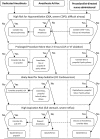Sedation in the Electrophysiology Laboratory: A Multidisciplinary Review
- PMID: 27412904
- PMCID: PMC4937286
- DOI: 10.1161/JAHA.116.003629
Sedation in the Electrophysiology Laboratory: A Multidisciplinary Review
Keywords: ablation; anesthesia; cardioversion; electrophysiology; pacemakers.
Figures



Similar articles
-
Sedation in cardiac arrhythmias management.Expert Rev Cardiovasc Ther. 2018 Mar;16(3):163-173. doi: 10.1080/14779072.2018.1429914. Epub 2018 Jan 21. Expert Rev Cardiovasc Ther. 2018. PMID: 29338549 Review.
-
Proposed Guideline Revisions for Dental Sedation and General Anesthesia: Why Target the Safest Level of Sedation?Compend Contin Educ Dent. 2016 Sep;37(8):546-52. Compend Contin Educ Dent. 2016. PMID: 27608198
-
Sedation: A Primer for Pediatricians.Pediatr Ann. 2018 Jun 1;47(6):e254-e258. doi: 10.3928/19382359-20180522-04. Pediatr Ann. 2018. PMID: 29898238 Review.
-
Procedural sedation and analgesia for adults in the emergency department.BMJ. 2014 May 8;348:g2965. doi: 10.1136/bmj.g2965. BMJ. 2014. PMID: 24812113 No abstract available.
-
2015 ACC/AHA/HRS Advanced Training Statement on Clinical Cardiac Electrophysiology (A Revision of the ACC/AHA 2006 Update of the Clinical Competence Statement on Invasive Electrophysiology Studies, Catheter Ablation, and Cardioversion).Heart Rhythm. 2016 Jan;13(1):e3-e37. doi: 10.1016/j.hrthm.2015.09.014. Epub 2015 Sep 24. Heart Rhythm. 2016. PMID: 26392325 No abstract available.
Cited by
-
Anesthetic practice during cardiac implantable electronic device implant procedures: A retrospective, single-center study.Int J Cardiol Heart Vasc. 2023 Nov 24;49:101312. doi: 10.1016/j.ijcha.2023.101312. eCollection 2023 Dec. Int J Cardiol Heart Vasc. 2023. PMID: 38076344 Free PMC article.
-
Feasibility and Accuracy of Noninvasive Continuous Arterial Pressure Monitoring during Transcatheter Atrial Fibrillation Ablation.J Clin Med. 2023 Mar 20;12(6):2388. doi: 10.3390/jcm12062388. J Clin Med. 2023. PMID: 36983388 Free PMC article.
-
Coronary vasospasm caused by intravenous infusion of dexmedetomidine: Unrecognized pitfall of catheter ablation procedures of atrial fibrillation.J Cardiol Cases. 2019 Aug 27;20(6):221-224. doi: 10.1016/j.jccase.2019.08.010. eCollection 2019 Dec. J Cardiol Cases. 2019. PMID: 31762838 Free PMC article.
-
Laryngeal mask airway versus endotracheal intubation as general anesthesia airway managements for atrial fibrillation catheter ablation: a comparative analysis based on propensity score matching.J Interv Card Electrophysiol. 2024 Sep;67(6):1377-1390. doi: 10.1007/s10840-024-01742-w. Epub 2024 Jan 16. J Interv Card Electrophysiol. 2024. PMID: 38225533
-
Sacrificing patient comfort to avoid sedative/analgesic suppression of supraventricular tachycardia inducibility during ablation: no pain, no gain?J Interv Card Electrophysiol. 2024 Mar;67(2):233-234. doi: 10.1007/s10840-023-01667-w. Epub 2023 Nov 3. J Interv Card Electrophysiol. 2024. PMID: 37922054 No abstract available.
References
-
- American Society of Anesthesiologists Task Force on Sedation, Analgesia by Non‐anesthesiologists . Practice guidelines for sedation and analgesia by non‐anesthesiologists. Anesthesiology. 2002;96:1004–1017. - PubMed
-
- Gaitan BD, Trentman TL, Fassett SL, Mueller JT, Altemose GT. Sedation and analgesia in the cardiac electrophysiology laboratory: a national survey of electrophysiologists investigating the who, how, and why? J Cardiothorac Vasc Anesth. 2011;25:647–659. - PubMed
-
- Sayfo S, Vakil KP. Alqaqa'a A, Flippin H, Bhakta D, Yadav AV, Miller JM, Groh WJ. A retrospective analysis of proceduralist‐directed, nurse‐administered propofol sedation for implantable cardioverter‐defibrillator procedures. Heart Rhythm. 2012;9:342–346. - PubMed
-
- Salukhe TV, Willems S, Drewitz I, Steven D, Hoffmann BA, Heitmann K, Rostock T. Propofol sedation administered by cardiologists without assisted ventilation for long cardiac interventions: an assessment of 1000 consecutive patients undergoing atrial fibrillation ablation. Europace. 2012;14:325–330. - PubMed
-
- Sairaku A, Yoshida Y, Hirayama H, Nakano Y, Ando M, Kihara Y. Procedural sedation with dexmedetomidine during ablation of atrial fibrillation: a randomized controlled trial. Europace. 2014;16:994–999. - PubMed
Publication types
MeSH terms
Substances
LinkOut - more resources
Full Text Sources
Other Literature Sources

